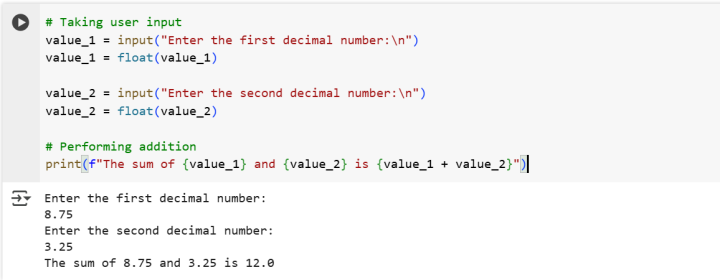Convert String to Float in Python (Python String to Float)
In Python, type conversion functions allow us to change one data type into another. This article focuses on converting a string into a floating-point number.
Python provides the float() function for this purpose, which converts a string representation of a number into a float. Similarly, the int() function can convert a string into an integer.
How to Convert String to Float in Python? (String Float)
You can use different methods for converting a string into a floating-point number, including:
- Using float() to parse a string into a float
- Converting a string to a float with a specific number of decimal places
- Using NumPy to convert a string into a float
1. Convert String to Float: Using float() to Parse a String to Float
In Python, we can convert a string to a floating-point number using the built-in float() function, which changes the data type of the given string. This built-in function is used to transform an object into a floating-point number. Internally, the float() function calls the object's __float__() method to perform the conversion. In this way, you can convert string to float easily.
Example:
value = "45.67"# Convert string to float using float()
num = float(value)
print(num)
print(type(num))Output:

2. Convert String to Float with Specific Decimal Places
To convert a string to a float while ensuring a fixed number of decimal places, you can use float() along with string formatting.
Example
num_str = "74.9823456"
decimal_places = 3# Convert string to float
float_value = float(num_str)# Format to specific decimal places
formatted_float = "{:.{}f}".format(float_value, decimal_places)
print(formatted_float)Output:

The above method ensures that the float is rounded to the desired number of decimal places.
3. Convert String to Float Using NumPy
NumPy provides the numpy.float64 data type, which allows you to convert string to float. This method is useful when working with numerical computations and large datasets, as NumPy offers efficient data handling.
Example:
import numpy as np# String containing a decimal number
num_str = "42.89"# Convert string to float using numpy.float64
float_value = np.float64(num_str)
print(float_value)
print(type(float_value))Output:

<class 'numpy.float64'>Explanation:
Import NumPy: The NumPy module is imported to access its functionalities.
Convert String to Float: The numpy.float64() function is used to convert the string "42.89" into a floating-point number.
Output and Type Check: The converted value is printed, along with its data type, which confirms it is a numpy.float64 type instead of a standard Python float.
This approach is particularly useful when working with arrays and mathematical computations in NumPy.
Why Convert a String to a Float? (Convert String to Float)
When receiving numerical input from a user through the terminal or reading data from a file, the values are initially stored as strings. To perform mathematical operations like addition, subtraction, or multiplication, you must explicitly convert them into floating-point numbers using the float() function.
Example:
# Taking user input
value_1 = input("Enter the first decimal number:\n")
value_1 = float(value_1)
value_2 = input("Enter the second decimal number:\n")
value_2 = float(value_2)# Performing addition
print(f"The sum of {value_1} and {value_2} is {value_1 + value_2}")Output:

The sum is calculated correctly because the input values are converted from strings to floating-point numbers before operating.
Handling Invalid Input with Try-Except
To prevent errors when a user enters invalid input, it’s recommended to use a try-except block.
Example with Exception Handling:
try:
num1 = float(input("Enter the first floating-point number:\n"))
num2 = float(input("Enter the second floating-point number:\n"))
print(f"The sum of {num1} and {num2} is {num1 + num2}")except ValueError:
print("Invalid input! Please enter numeric values.")Output:

This ensures the program doesn't crash if the user enters non-numeric input.
How to Convert a Float to a String Using str()?
You can convert a floating-point number into a string using the str() function in Python. This is useful when concatenating float values as part of a sentence or formatted output.
Example:
num1 = 15.75
num2 = 8.42
num3 = 27.89# Using str() to concatenate float values
print(f'Combining {num1} and {num2} gives: {str(num1) + str(num2)}')# Creating a space-separated string from float values
print(f'Formatted output: {str(num1)} {str(num2)} {str(num3)}')# Using join() to create a dash-separated string
print(f'Dash-separated values: {" - ".join([str(num1), str(num2), str(num3)])}')Output:

In the first output, num1 and num2 are converted to strings and concatenated directly. The second output presents the numbers as a space-separated string, while the third uses join() to create a formatted string with dashes.
Conclusion
To handle various data types efficiently, one must know how to convert string to float in Python. When executing string-specific operations, such as concatenation or formatted output, it is helpful to convert a float to a string. On the other hand, we can carry out numerical operations like addition and multiplication by converting a string to a float.
When working with enormous datasets, NumPy's float64 and built-in functions like float() and str() allow us to easily swap between data types according to our needs. When conversions are handled correctly, our programs operate effectively and prevent possible type-related mistakes.
If you’re looking for high-performance dedicated servers with scalability, customization, and unlimited traffic, BlueServers has you covered! Upgrade your hosting experience with a reliable, dedicated environment tailored to your business needs. Visit BlueServers.com to get started today!
Blog